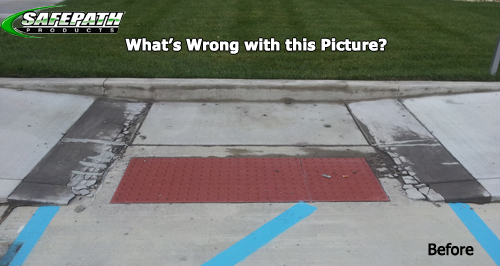While concrete is strong and solid it expands and contracts, which can cause cracking and breaking up. Compared to rubber threshold ramps, this is especially true when attempting to bring a concrete edge to a thin layer, as when making a ramp. Concrete in thin applications is vulnerable to cracking, even when using plasticizers.
Concrete ramps or transitions often have to comply with the American with Disability Act, (ADA) where the edge of any ramp cannot be greater than a vertical ¼”. This is difficult to, especially in retro-fit applications when applying concrete on top of existing concrete, it often results in disaster with cracking and chipping due to expansion and contraction (as can be seen in the picture above).
The expense of saw-cutting and abrading is a way of remedying this problem; however, this can be costly and require building permits, setting and removal of forms, and the disposal of materials.
A quick and affordable remedy for this problem is to use a recycled rubber finishing edge part for the leading edge of the concrete ramp. Recycled rubber  performs well; especially in inclement weather. It also offers a valuable visual cue to the pedestrian that there is an impending rise in the walkway. Moreover, the material properties in recycled rubber provide for an increased and superior Static Coefficient of Friction (SCOF) rating for the surface, which indicates the slipperiness of a particular surface.
performs well; especially in inclement weather. It also offers a valuable visual cue to the pedestrian that there is an impending rise in the walkway. Moreover, the material properties in recycled rubber provide for an increased and superior Static Coefficient of Friction (SCOF) rating for the surface, which indicates the slipperiness of a particular surface.
Recycle rubber ramp products come in various sizes and heights. Rubber ramps or reducers are adhered with high grade silicone adhesive and have a long life cycle. When selecting a recycled rubber ramp product it is important to look for a high durometer rated product, (this indicates the density or hardness of the product). It is also important to specify no silicone on the product, as many manufacturers use silicone or similar product as a mold release agent. This can interfere with proper adhesion of the rubber to the substrate.
The use of recycled tires in conjunction with concrete makes for a fast and affordable fix that uses natural recycled resources that otherwise are headed for the landfill. More importantly, recycled rubber transitions serve a valuable and effective safe solution that does not freeze or crack in weather or with use. After all, ramp and transition projects should never result in a “breakup” between you and your valued customer.
EZ Edge Rubber Threshold Ramp Features
- Made from durable, all-weather, 100% recycled rubber
- Installation is quick and easy, significantly reducing labor costs
- Most often used for door thresholds, sliding glass doors, entry ways, or any path of travel with a vertical barrier
- Superior slip resistance
- Unlimited weight capacity
- Easily roll a wheelchair or scooter over thresholds and through doorways
- Versatile rubber design accommodates a step or door jamb from 1/2″ to 2-3/4″ high
- Easily cut to fit into and around moldings
- Ideal for wheelchair access to homes or businesses
- Used for interior and exterior applications
- Durable and maintenance free
- Easily washed with soap and water
- UV stable
- Only ramp to exceed ADA requirements in the market
Timothy Vander Heiden
CEO of SafePath Products
About the author: Timothy Vander Heiden, J.D. is the CEO of SafePath Products and Van Duerr Industries, Inc. With over 25 years of experience manufacturing and marketing products for ADA compliance, Timothy specialized in green technology for the architectural marketplace. SafePath Products is continually producing the largest selection of recycled accessibility products in the industry. The SafePath Products team can be reached at 1-800-497-2003 or Info@safepathproducts.com, we look forward to hearing from you.
